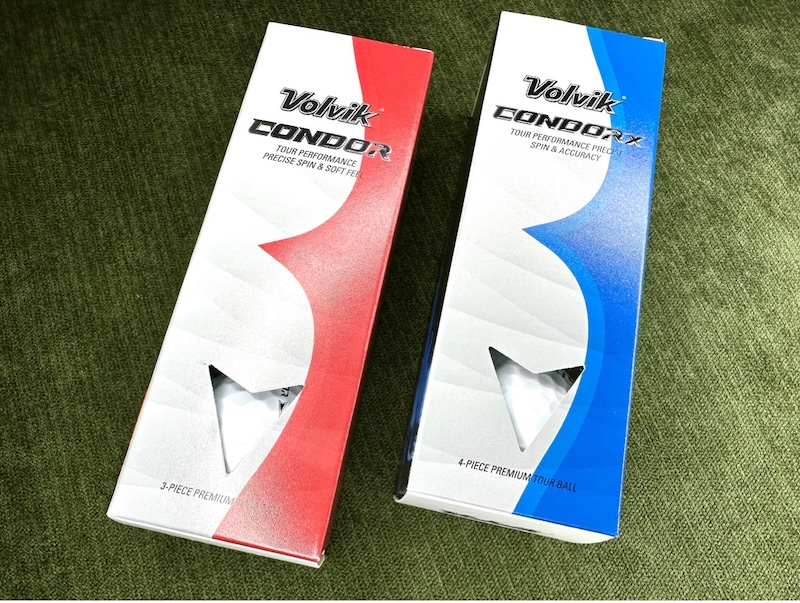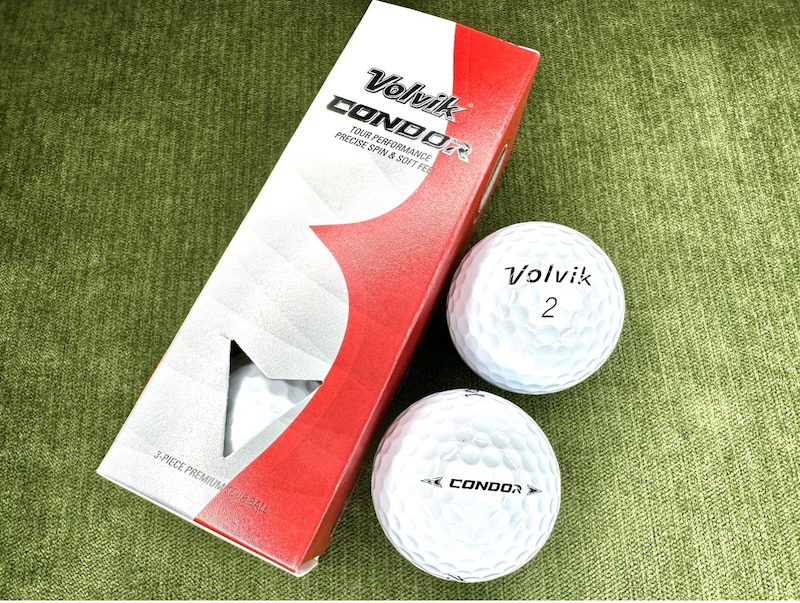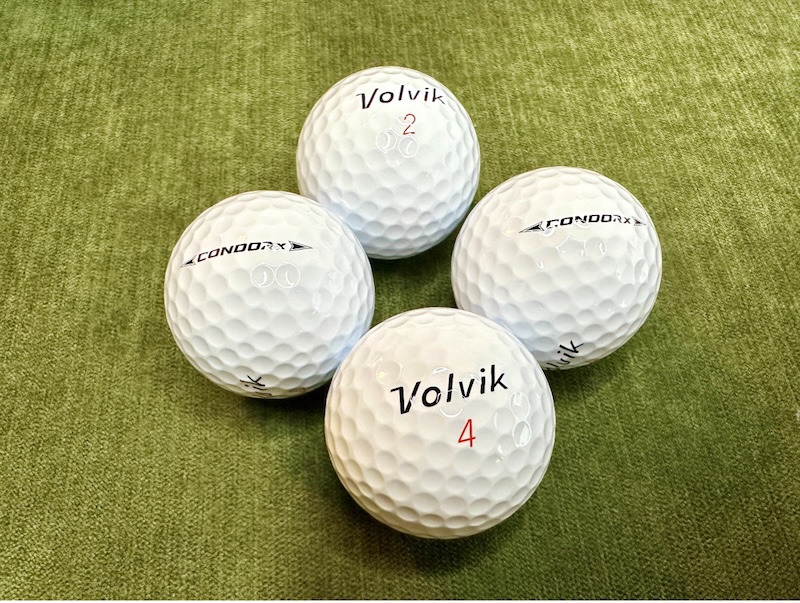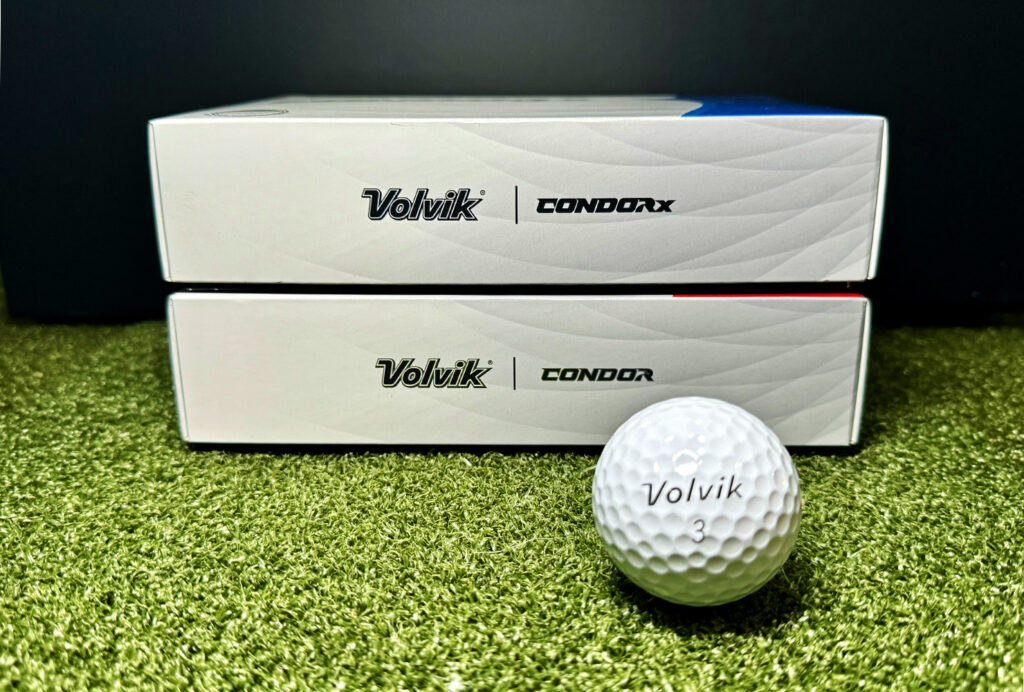Volvik Condor and Condor X Golf Balls Review
Volvik is a brand that has seamlessly injected the fun element of golf into their product lines. Their inventory boasts an extensive range of golf balls, many featuring vibrant colors, and some even contain superhero emblems. However, despite their playful approach, Volvik still strives to reach the golfer who is more focused on performance, and that is the golfer they are targeting with their two newest offerings within their Tour Performance line, the Condor and Condor X golf balls.

Since Volvik positions these golf balls as their tour balls, it should be no surprise that they both come with a soft cast urethane cover, which is here to help give increased and consistent spin, but the real story about the Condor line is what is happening on the inside.
Condor is the first golf ball to incorporate a new white carbon material commonly found in high-end tires. This material has high density and cohesion, which ensures that energy transfer is not lost and that the rubber does not age. Thanks to this material, the ball’s core employs increased elastic energy that gathers and releases the condensed force at the moment of impact. In simpler terms, adding white carbon improves the rebound efficiency and ball speed.

One of the distinguishing features between Condor and Condor X is their structural setup. Condor is a three-piece golf ball, while Condor X utilizes a fourth layer as part of a Hyper W-Carbonic and Elastin Dual Mantle design. Additionally, in terms of compression rating, the Condor possesses a compression rating of 85, which is ten lower than that of the Condor X.
While warmer weather is on the horizon, we could not get these balls out on the golf course during the review period. However, with the help of a SkyTrak+ unit, I captured all the data needed to see how these two balls performed for my swing. Below is a chart of how these balls performed with a driver, 7-iron, and SW.

Condor

Condor X

As you can see, there were some similarities in numbers between these two balls, but also several differences. One of the most noticeable differences was the peak height achieved when using a driver. As you can see, Condor X peaked 7 yards higher than the Condor, and in all of the sessions I compared these two balls, Condor X carried a higher peak every single time. Condor also flew slightly lower when comparing 7-irons and spun less across the board. Both options also provided plenty of spin during the wedge test, meaning there would be no worries about stopping these balls quickly on the green. Volvik does mention that a differentiating factor between these two balls is the amount of spin, with the Condor X being the higher-spinning ball of the two, so I am glad to see that is how it tested out for me as well.
Testing data is valuable, it does not reveal how these balls sound or feel. After hitting each ball with various clubs throughout the bag, the Condor has a slight advantage for my preference. However, the difference is minimal compared to other brands that offer two different variants of the same line. The tone of the Condor is only slightly deeper than that of the Condor X.

Although not entirely relevant to the review itself, one question that inevitably arises is which option is better suited for my game when comparing two similar products. Based on my testing process, I would likely put the Condor in play first. As someone who tends to launch the ball high, I typically play a golf ball with a slightly flatter trajectory off the tee and with my irons. Currently, the Condor fits that bill. It will be interesting to see how both balls play out on the course in the future.
Volvik’s new Condor series is available at a retail price of $42.99 per dozen. More information is available at www.volvik.com.












[QUOTE=”ddec, post: 12321476, member: 782″]
When going through this type of side by side comparison, are you looking in at the consistency of strike locations? Are these misses pulls/pushes or are they starting right and curving left or the opposite depending on your normal ball flight?
[/QUOTE]
That’s a good point. I was trying to take into account a strike location, and where I would expect, with that feel, the ball should end up. I’m a decent ball striker, but like to explore the face throughout a round. Side by side, I was missing with the Condor on a shot that was going left to right. My usual, I would expect them to still catch the right side of the fairway, but the Condor seemed to leak a bit more than my gamer.
I should have mentioned this too, but I didnt get the best of breaks on bounces with the Condor. Caught the right side of the fairway, but then the rough sloped away, as an example. Seemed like one of those rounds where the bounces just weren’t going my way.
Plan to play the Condor and Condor X just the same next round out and will continue to report back.
[QUOTE=”GLG20, post: 12321500, member: 53807″]
I was far from being consistent with either the Condor or the B RX off the tee yesterday (all me). Big fades and push fades. Was worse into a slight breeze, maybe 10 mph.
[/QUOTE]
and when it’s going like that on the course, it’s kind of hard to get a real feel for what is going on with the ball. Not to say you can’t take away certain aspects.
[QUOTE=”ddec, post: 12321528, member: 782″]
and when it’s going like that on the course, it’s kind of hard to get a real feel for what is going on with the ball. Not to say you can’t take away certain aspects.
[/QUOTE]
Absolutely, I was having a bad driver day. My comments about the irons 150 and in, the wedges and putter were what I was focusing on.
[QUOTE=”ddec, post: 12321476, member: 782″]
When going through this type of side by side comparison, are you looking in at the consistency of strike locations? Are these misses pulls/pushes or are they starting right and curving left or the opposite depending on your normal ball flight?
[/QUOTE]
For me, I always look at strike location. This is especially important for me on driver. I’ve been pretty consistent with my ball striking lately (which still isn’t good, but consistent is better for me). I do want to make note of what happens on a mis-hit, but I pay more attention to what happens on an intended strike.
[QUOTE=”ddec, post: 12321469, member: 782″]
I’m lazy so I apologize if you’ve posted this. What ball(s) do you normally play?
[/QUOTE]
Q star tour is my main go to.
[QUOTE=”bsbmike5, post: 12321093, member: 8099″]
How does everyone feel in the confidence of the ball compared to their current gamer? I feel like there’s been a fair amount of abandoning the volvik during rounds to go back to the gamer.
Is there a lack of that confidence when playing it? Thanks guys!
[/QUOTE]
I have no lack of confidence in either balls. Off the tee they all have performed well. My only issue and its probably more of a me issue is that the Condor and X seem to roll out more than my Qstar on chips. I hope to get out to a Par 3 course next week before my league and try to focus on approach and chips more than I can during league play. But confidence wise I have no problem with either ball.
[QUOTE=”jdtox, post: 12321013, member: 5944″]
Hows the testing going?
[/QUOTE]
Today was my 1st day of League play. I played the Condor on the front nine and the Condorx on the back. Today was beautiful except for the constant 25 mph wind. Pretty happy with the ball flight into the wind. I was able to keep the ball flight down off the tee and distance for me was comparable to my Qstar. My usual Driver distance is 220-240 and I did not perceive any distance loss or gain. It was a first for me in quite sometime that I was able to play each ball for nine holes w/o losing one(I can’t remember the last time I didn’t lose multiple during a round!) With the wind behind me I got quite a bit of rollout on each ball and when wind was gusting from left or right I did not notice the wind having an adverse effect. Of the 2 (Condor/Condor X) Condor X surprised me as I hit some of my straightest shots when I had wind coming from either side.
While I was really happy with my driving, my iron swing was a bit inconsistent (not the balls fault). But the sound and feel off the irons was fine and each ball I used for 9 holes held up really well.
Chipping and putting with me today was terrible. I detected a louder click off the putter face with the X than I did with the Condor. A little off putting (no pun intended) but nothing too crazy, I prefer a softer ball putting. Wedges were inconsistent(me problem) but did hit a great shot with my 52 degree wedge from 70 yards into a strong head wind which stopped and spun back a bit. I just need to work on my short game next week and try to get these to check a bit more.
Well today I played in my league, Back 9 so it was the same holes that I reviewed the Reg Condor. Yes, I did try and play the X last week but too frickin cold, wind gust and just nit ideal for reviewing. Today, 78*, slight wind but really not gusting. Tried the #4 RED Volvik, to be brutally honest: HATED IT. I didn’t get any distance (we figured maybe 165yds), but hey it’s a Par 5. Next shot was 3W, LOVED IT. Got a respective 185yds + roll. 3rd was appox 140yd to the hole, tried a 5I (ok folks b4 you chime in; 60+yr old golfer, HCP 20+, swing speed tween 78-85) placed my shot on the fringe, very happy since the last time I play this hole I Par’d it. Putted from my spot and the Volvick CondorX, felt nice off my putter. No strange breaking/variances but direct roll to my target. So far this ball was just as good as the Reg Condor (IMO). Tee’d off on hole 2, same feel off the tee, wasn’t a fan. Hole 2 is a straight Par 4 playing into the wind and I didn’t get help off the tee. I ended up about 180 from the green and the wind started to pick up. OK, time for my 5W, try and keep it low to take the wind outta play, BINGO. Landed on the fringe but 50″ from the pin. Another Bogey.
I have to say that after playing my round; and not putting you all to sleep; IMO, this Volvik CondorX is a very nice ball however, IMO I believe that the REG Condor suited my personal feel better. Next week I will pu the Condor Soft into play, which should be very compatible to my Srixon Soft Ball line since I do play them too. Until next wee folks……..
[QUOTE=”ddec, post: 12321403, member: 782″]
I’m really susprised to see the comments about loss of confidence off the tee.
[/QUOTE]
The condor waa very good off the tee for me.
[USER=1193]@Hawk[/USER]
Hey hawkman! Ok. Got on a sim and hit some 50 and 100 yard shots. The results have me scratching my head a bit. I hit the condor (sadly don’t have any of the 3 condor x left after a couple rounds) and a control ball of the chrome soft X Ls that has been my primary ball for a bit..
These shots were all hit with a Mizuno T24 58 degree wedge bent to 59 degrees.
So first the condor at 50 yards. Distance control was a bit of a struggle. I chalk that up to a struggling short game of late and hitting indoors it is kind of hard to judge distance for me. But you will see in a second that I did better with the chrome soft. I was not surprised based off previous experience that the condor was the lower spinning of the two here. It seemed to confirm my thoughts.
[ATTACH type=”full” alt=”IMG_4607.jpeg”]9262460[/ATTACH]
Chrome soft at 50 yards.[ATTACH type=”full” alt=”IMG_4609.jpeg”]9262461[/ATTACH]
Here is where I get a little confused.. look at the numbers below.. the condor both flew lower and with a higher spin than the chrome soft LS.. it also was more consistent for me.. so I am a bit confused. My guess is there is a cover and mantle difference that is causing this. Maybe the cover on the condor is firmer so I am not engaging it as well on the shorter shots but at a 100 yards I am hitting it better to getting better reaction from the mantle layer.. Total guess!! I honestly have no clue but that would make sense to me.
Condor at 100
[ATTACH type=”full” alt=”IMG_4610.jpeg”]9262462[/ATTACH]
Chrome soft LS at 100.
[ATTACH type=”full” alt=”IMG_4611.jpeg”]9262463[/ATTACH]
[QUOTE=”Templet0n, post: 12322549, member: 53139″]
[USER=1193]@Hawk[/USER]
Hey hawkman! Ok. Got on a sim and hit some 50 and 100 yard shots. The results have me scratching my head a bit. I hit the condor (sadly don’t have any of the 3 condor x left after a couple rounds) and a control ball of the chrome soft X Ls that has been my primary ball for a bit..
These shots were all hit with a Mizuno T24 58 degree wedge bent to 59 degrees.
So first the condor at 50 yards. Distance control was a bit of a struggle. I chalk that up to a struggling short game of late and hitting indoors it is kind of hard to judge distance for me. But you will see in a second that I did better with the chrome soft. I was not surprised based off previous experience that the condor was the lower spinning of the two here. It seemed to confirm my thoughts.
[ATTACH type=”full” alt=”IMG_4607.jpeg”]9262460[/ATTACH]
Chrome soft at 50 yards.[ATTACH type=”full” alt=”IMG_4609.jpeg”]9262461[/ATTACH]
Here is where I get a little confused.. look at the numbers below.. the condor both flew lower and with a higher spin than the chrome soft LS.. it also was more consistent for me.. so I am a bit confused. My guess is there is a cover and mantle difference that is causing this. Maybe the cover on the condor is firmer so I am not engaging it as well on the shorter shots but at a 100 yards I am hitting it better to getting better reaction from the mantle layer.. Total guess!! I honestly have no clue but that would make sense to me.
Condor at 100
[ATTACH type=”full” alt=”IMG_4610.jpeg”]9262462[/ATTACH]
Chrome soft LS at 100.
[ATTACH type=”full” alt=”IMG_4611.jpeg”]9262463[/ATTACH]
[/QUOTE]
Those numbers seem pretty comparable to me. The full swing is interesting though
[QUOTE=”Templet0n, post: 12322549, member: 53139″]
[USER=1193]@Hawk[/USER]
Hey hawkman! Ok. Got on a sim and hit some 50 and 100 yard shots. The results have me scratching my head a bit. I hit the condor (sadly don’t have any of the 3 condor x left after a couple rounds) and a control ball of the chrome soft X Ls that has been my primary ball for a bit..
These shots were all hit with a Mizuno T24 58 degree wedge bent to 59 degrees.
So first the condor at 50 yards. Distance control was a bit of a struggle. I chalk that up to a struggling short game of late and hitting indoors it is kind of hard to judge distance for me. But you will see in a second that I did better with the chrome soft. I was not surprised based off previous experience that the condor was the lower spinning of the two here. It seemed to confirm my thoughts.
[ATTACH type=”full” alt=”IMG_4607.jpeg”]9262460[/ATTACH]
Chrome soft at 50 yards.[ATTACH type=”full” alt=”IMG_4609.jpeg”]9262461[/ATTACH]
Here is where I get a little confused.. look at the numbers below.. the condor both flew lower and with a higher spin than the chrome soft LS.. it also was more consistent for me.. so I am a bit confused. My guess is there is a cover and mantle difference that is causing this. Maybe the cover on the condor is firmer so I am not engaging it as well on the shorter shots but at a 100 yards I am hitting it better to getting better reaction from the mantle layer.. Total guess!! I honestly have no clue but that would make sense to me.
Condor at 100
[ATTACH type=”full” alt=”IMG_4610.jpeg”]9262462[/ATTACH]
Chrome soft LS at 100.
[ATTACH type=”full” alt=”IMG_4611.jpeg”]9262463[/ATTACH]
[/QUOTE]
I appreciate you putting this up! Sorry for the delay – my evenings are insane right now. I think you may be on to something with your thoughts about the mantle layer impacting spin at those different speeds. I can see where you’re noticing some difference visually in those 50 yard shots. The numbers are wildly different, but different enough to be noticeable I think.
[QUOTE=”Coloradomrg, post: 12321134, member: 61066″]
I haven’t bailed on the Volvick yet, and may actually turn it into my gamer for the season. The Condor x is a little too stiff and spinny for me off the driver, the Condor is great. Maybe a touch too spinny off the driver, but feels great otherwise. The XT Soft is really good for me. I have a round with [USER=10934]@J4U[/USER] on Friday. Hoping he’ll test out the X a bit and let us know his thoughts.
[/QUOTE]
Oh absolutely! Will give it a go for sure!
However:
[QUOTE=”Coloradomrg, post: 12321139, member: 61066″]
I also haven’t lost any of the volvick balls yet… not sure what the correlation is but I have been keeping them in play!
[/QUOTE]
No promises :LOL:
[QUOTE=”jdtox, post: 12323180, member: 5944″]
Those numbers seem pretty comparable to me. The full swing is interesting though
[/QUOTE]
Yeah not loads different
Played the standard Condor last night for my first night of league on a course I’m familiar with. Conditions last night were decent with low 70’s temps and sunshine however we were playing in 30-40mph winds on an open course so the wind was challenging to say the least.
Looks
I like the logo and the looks of the ball, the color is a nice bright white. I do see the seam pretty easily if looking but is that really that big of deal? I don’t think so.
Feel
I think the Condor feels great off of all clubs, not too soft and definitely not hard.
Performance
Driver: In the wind I found the ball to perform decently enough to where I can’t say its any better or worse than any other ball would do in those conditions. Into the wind it did spin up a few times off driver and conversely with the wind it flew quite well. I found the ball to fly pretty straight for me, never spinning too much side to side either. For the round according to Shot Scope I hit 71% of fairways last night which is pretty darn good.
Irons: Here is where I’m seeing some anomalies compared to my gamer ball. I noticed this at Briggs ranch a few weeks ago and again last night. I’m almost a full club longer with this ball compared to what I’m used to which I can only attribute to being lower spin I think? I flew 2 greens last night, its possible the wind played a roll here but I’m going to keep an eye on this going forward but its now a couple times I’ve noticed this.
Here is a 7i off a par 3 tee that was struck about as pure as I can hit it, as you can see the ball stopped in plenty of time BUT with my gamer I will usually see the ball stop much closer to the mark. Will be curious to see how the X compares when I try it out here soon.
[ATTACH type=”full”]9262538[/ATTACH]
Wedges
I didn’t really have any shots last night where I was hitting a shot with a wedge that I could test spin. The one full wedge I had from 100 yards got up in the wind and flew the green. Green side shots were ok
Putter
I think this ball feels great off the putter. Again not too soft nor hard and clicky sounding.
Overall I enjoyed the experience again and I like the ball. I could easily game it with a few adjustments but I do think the X could be a better fit for my game. We will put the X to the test soon.
[QUOTE=”jdtox, post: 12323235, member: 5944″]
Played the standard Condor last night for my first night of league on a course I’m familiar with. Conditions last night were decent with low 70’s temps and sunshine however we were playing in 30-40mph winds on an open course so the wind was challenging to say the least.
Looks
I like the logo and the looks of the ball, the color is a nice bright white. I do see the seam pretty easily if looking but is that really that big of deal? I don’t think so.
Feel
I think the Condor feels great off of all clubs, not too soft and definitely not hard.
Performance
Driver: In the wind I found the ball to perform decently enough to where I can’t say its any better or worse than any other ball would do in those conditions. Into the wind it did spin up a few times off driver and conversely with the wind it flew quite well. I found the ball to fly pretty straight for me, never spinning too much side to side either. For the round according to Shot Scope I hit 71% of fairways last night which is pretty darn good.
Irons: Here is where I’m seeing some anomalies compared to my gamer ball. I noticed this at Briggs ranch a few weeks ago and again last night. I’m almost a full club longer with this ball compared to what I’m used to which I can only attribute to being lower spin I think? I flew 2 greens last night, its possible the wind played a roll here but I’m going to keep an eye on this going forward but its now a couple times I’ve noticed this.
Here is a 7i off a par 3 tee that was struck about as pure as I can hit it, as you can see the ball stopped in plenty of time BUT with my gamer I will usually see the ball stop much closer to the mark. Will be curious to see how the X compares when I try it out here soon.
[ATTACH type=”full” alt=”IMG_6146.png”]9262538[/ATTACH]
Wedges
I didn’t really have any shots last night where I was hitting a shot with a wedge that I could test spin. The one full wedge I had from 100 yards got up in the wind and flew the green. Green side shots were ok
Putter
I think this ball feels great off the putter. Again not too soft nor hard and clicky sounding.
Overall I enjoyed the experience again and I like the ball. I could easily game it with a few adjustments but I do think the X could be a better fit for my game. We will put the X to the test soon.
[/QUOTE]
Remind me what ball you normally play.
I would agree that lower spin would be a good place to look first when it comes to differences in your expected carry distances.
[QUOTE=”Hawk, post: 12323252, member: 1193″]
Remind me what ball you normally play.
I would agree that lower spin would be a good place to look first when it comes to differences in your expected carry distances.
[/QUOTE]
Yeah I don’t have numbers but it was happening at Briggs to the point where I had to club down after day 1, yesterday was the first time I got out since being back and noticed it again. I can’t imagine the spin is that much lower but the flight is definitely lower which would mean descent is also
Pv1x or CSX, this year Chrome Tour or Tour X most likely but I usually play the X balls. I have the speed for them and I like spin around the greens.
[QUOTE=”jdtox, post: 12323266, member: 5944″]
Yeah I don’t have numbers but it was happening at Briggs to the point where I had to club down after day 1, yesterday was the first time I got out since being back and noticed it again. I can’t imagine the spin is that much lower but the flight is definitely lower which would mean descent is also
Pv1x or CSX, this year Chrome Tour or Tour X most likely but I usually play the X balls. I have the speed for them and I like spin around the greens.
[/QUOTE]
Great feedback. I like a nice middle ground feeling golf ball. Not sure why I didn’t give these a try a couple weeks ago.
[QUOTE=”Hawk, post: 12323280, member: 1193″]
Great feedback. I like a nice middle ground feeling golf ball. Not sure why I didn’t give these a try a couple weeks ago.
[/QUOTE]
I think you would like them and the price is good too. I played the X at Briggs also and commented on a couple things but going to wait for till I put it in play here locally just like I did with the regular version to see if things are the same.
[QUOTE=”jdtox, post: 12323235, member: 5944″]
Played the standard Condor last night for my first night of league on a course I’m familiar with. Conditions last night were decent with low 70’s temps and sunshine however we were playing in 30-40mph winds on an open course so the wind was challenging to say the least.
Looks
I like the logo and the looks of the ball, the color is a nice bright white. I do see the seam pretty easily if looking but is that really that big of deal? I don’t think so.
Feel
I think the Condor feels great off of all clubs, not too soft and definitely not hard.
Performance
Driver: In the wind I found the ball to perform decently enough to where I can’t say its any better or worse than any other ball would do in those conditions. Into the wind it did spin up a few times off driver and conversely with the wind it flew quite well. I found the ball to fly pretty straight for me, never spinning too much side to side either. For the round according to Shot Scope I hit 71% of fairways last night which is pretty darn good.
Irons: Here is where I’m seeing some anomalies compared to my gamer ball. I noticed this at Briggs ranch a few weeks ago and again last night. I’m almost a full club longer with this ball compared to what I’m used to which I can only attribute to being lower spin I think? I flew 2 greens last night, its possible the wind played a roll here but I’m going to keep an eye on this going forward but its now a couple times I’ve noticed this.
Here is a 7i off a par 3 tee that was struck about as pure as I can hit it, as you can see the ball stopped in plenty of time BUT with my gamer I will usually see the ball stop much closer to the mark. Will be curious to see how the X compares when I try it out here soon.
[ATTACH type=”full” alt=”IMG_6146.png”]9262538[/ATTACH]
Wedges
I didn’t really have any shots last night where I was hitting a shot with a wedge that I could test spin. The one full wedge I had from 100 yards got up in the wind and flew the green. Green side shots were ok
Putter
I think this ball feels great off the putter. Again not too soft nor hard and clicky sounding.
Overall I enjoyed the experience again and I like the ball. I could easily game it with a few adjustments but I do think the X could be a better fit for my game. We will put the X to the test soon.
[/QUOTE]
So it’s not just me with the distance on iron shots with the condor. ?